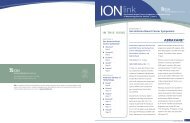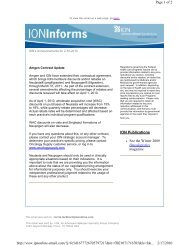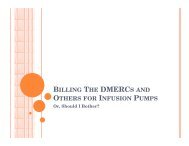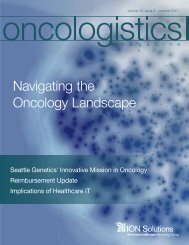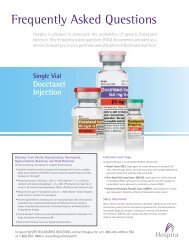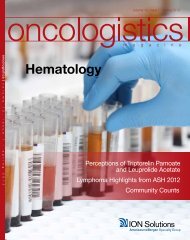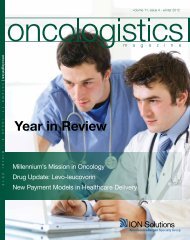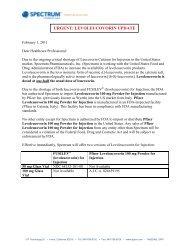First Quarter 2008 - Issues in Hematology - ION Solutions
First Quarter 2008 - Issues in Hematology - ION Solutions
First Quarter 2008 - Issues in Hematology - ION Solutions
- No tags were found...
You also want an ePaper? Increase the reach of your titles
YUMPU automatically turns print PDFs into web optimized ePapers that Google loves.
oncologistics drug updateNexavar ® <strong>in</strong> Unresectable HCC:New Treatment Option Basedon Significant Survival Benefitby: Ralph Boccia, M.D., F. A. C. P.Nexavar (sorafenib) is an oral multiple k<strong>in</strong>ase <strong>in</strong>hibitorthat, as of November 2007, became the first systemictherapy approved by the U.S. Food and DrugAdm<strong>in</strong>istration (FDA) for patients with unresectablehepatocellular carc<strong>in</strong>oma (HCC), the most common formof liver cancer. As the only agent that has demonstrateda significant survival advantage <strong>in</strong> patients withunresectable HCC, Nexavar offers new hope for thisdifficult-to-treat disease. The HCC <strong>in</strong>dication came with<strong>in</strong>2 years of Nexavar’s approval for advanced renal cellcarc<strong>in</strong>oma (RCC)–for which the agent is now approved <strong>in</strong>more than 60 countries.The <strong>in</strong>cidence of HCC has been ris<strong>in</strong>g <strong>in</strong> the UnitedStates and globally. Current estimates are thatapproximately 19,000 new HCC cases are diagnosedannually <strong>in</strong> the United States. 1 The classic late diseasestage at diagnosis and the lack of effective systemictherapies have contributed to the dismal 8% 3-yearsurvival rate among patients with advanced disease. 2SHARP Results Move HCC to the Era ofTargeted TherapyF<strong>in</strong>al results of the <strong>in</strong>ternational, double-bl<strong>in</strong>d, PhaseIII Sorafenib HCC Assessment Randomized Protocol(SHARP) trial, 3 which provided the basis for the FDA’sapproval of Nexavar <strong>in</strong> HCC, marked the first time anyagent has shown a survival advantage with predictableside effects <strong>in</strong> patients with unresectable HCC, and hasmoved HCC to the era of targeted therapy.The SHARP trial, reported at the 2007 annual meet<strong>in</strong>gof the American Society of Cl<strong>in</strong>ical Oncology, enrolled602 patients recruited from centers <strong>in</strong> North and SouthAmerica, Europe, Australia, and New Zealand. 3Patients had histologically proven unresectable ormetastatic HCC, had not received previous systemictherapy, Eastern Cooperative Oncology Group(ECOG) performance status of 0-2, and lifeexpectancy of > 12 weeks. Patients could have receivedlocal therapy, <strong>in</strong>clud<strong>in</strong>g surgery, radiotherapy, hepaticarterial embolization, chemoembolization radiofrequencyablation, percutaneous ethanol <strong>in</strong>jection, or cryoablation,as long as one target lesion had not been subjected tolocal therapy or a treated target lesion had <strong>in</strong>creased <strong>in</strong>size by 25%. Patients were randomly assigned to receiveoral Nexavar tablets 400 mg twice daily (n=299) orplacebo tablets twice daily (n=303) dosed cont<strong>in</strong>uously.Primary study end po<strong>in</strong>ts were overall survival (OS) andtime to symptom progression. Secondary end po<strong>in</strong>tswere time to disease progression and disease controlrate, def<strong>in</strong>ed as complete or partial response or stabledisease for at least two treatment cycles.Basel<strong>in</strong>e patient characteristics were similar <strong>in</strong> thetwo treatment groups. The median patient age wasapproximately 67 years, 87% were men, and 54% hadECOG performance status of 0. The majority of studyparticipants (> 95%) had Child-Pugh A liver functionstatus, approximately 82% had Barcelona Cl<strong>in</strong>ic LiverCancer (BCLC) stage C disease, and 70% had portalve<strong>in</strong> thrombosis.In February 2007, when 321 deaths had occurred(143 <strong>in</strong> the Nexavar arm, 178 <strong>in</strong> the placebo arm), thestudy was term<strong>in</strong>ated early, after a prescheduled <strong>in</strong>terimanalysis showed that the primary OS end po<strong>in</strong>toncologistics 2



